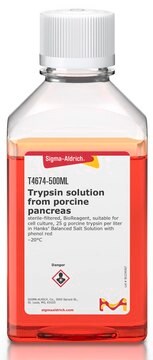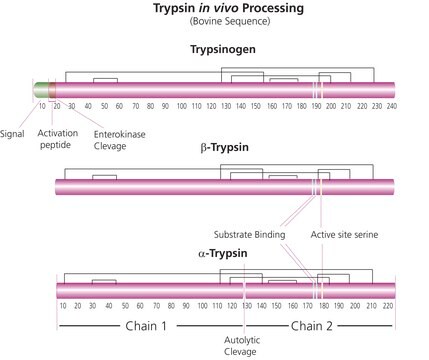T4424
Trypsin solution from porcine pancreas
1 ×, sterile-filtered, BioReagent, suitable for cell culture, 2.5 g porcine trypsin per liter in Hanks′ Balanced Salt Solution with phenol red
About This Item
Prodotti consigliati
Origine biologica
Porcine pancreas
Livello qualitativo
Sterilità
sterile-filtered
Nome Commerciale
BioReagent
Forma fisica
solution
PM
23.4 kDa
Concentrazione
1 ×
tecniche
cell culture | mammalian: suitable
Impurezze
Porcine parvovirus, none detected (9 CFR)
pH
7.0-7.6
Condizioni di spedizione
dry ice
Temperatura di conservazione
−20°C
Cerchi prodotti simili? Visita Guida al confronto tra prodotti
Applicazioni
For trypsin digestion of peptides, use a ratio of about 1:100 to 1:20 for trypsin:peptide. The typical use for this product is in removing adherent cells from a culture surface. The concentration of trypsin necessary to dislodge cells from their substrate is dependent primarily on the cell type and the age of the culture. Trypsins have also been used for the re-suspension of cells during cell culture, in proteomics research for digestion of proteins and in various in-gel digestions. Additional applications include assessing crystallization by membrane-based techniques and in a study to determine that protein folding rates and yields can be limited by the presence of kinetic traps.
Azioni biochim/fisiol
Serine protease inhibitors, including DFP, TLCK, APMSF, AEBSEF, and aprotinin, amongst others, will inhibit Trypsin.
Avvertenza
Definizione di unità
Nota sulla preparazione
Non trovi il prodotto giusto?
Prova il nostro Motore di ricerca dei prodotti.
Prodotti correlati
Codice della classe di stoccaggio
12 - Non Combustible Liquids
Classe di pericolosità dell'acqua (WGK)
WGK 3
Punto d’infiammabilità (°F)
Not applicable
Punto d’infiammabilità (°C)
Not applicable
Certificati d'analisi (COA)
Cerca il Certificati d'analisi (COA) digitando il numero di lotto/batch corrispondente. I numeri di lotto o di batch sono stampati sull'etichetta dei prodotti dopo la parola ‘Lotto’ o ‘Batch’.
Possiedi già questo prodotto?
I documenti relativi ai prodotti acquistati recentemente sono disponibili nell’Archivio dei documenti.
I clienti hanno visto anche
Protocolli
Trypsin may be used to remove adherent cells from a culture surface. Cells are most commonly removed from the culture substrate by treatment with trypsin or trypsin/EDTA solutions.
Trypsin is frequently used in cell dissociation from adherent surfaces. We offer a wide variety of trypsin solutions to meet your specific cell line requirements, as well as protocols, troubleshooting ideas, and more.
Il team dei nostri ricercatori vanta grande esperienza in tutte le aree della ricerca quali Life Science, scienza dei materiali, sintesi chimica, cromatografia, discipline analitiche, ecc..
Contatta l'Assistenza Tecnica.









